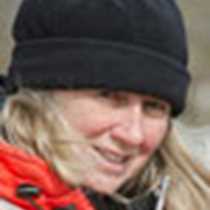Port Lockroy
How is it that the snow-coated glaciers could glow so white when the sky above was blanketed with a fluffy grey quilt? Only the occasional rent in the fabric revealed a blue sky where surely the sun shone brightly. It was through these tears that bright light entered to bounce from one reflective ice crystal to another and thus our view was illuminated. The scenes changed all day from Bismarck Strait, to the Neumayer Channel to Dallmann Bay and yet there was a sameness for each moment was a study of textures; smooth rounded caps on rocky hills mounded with ice and jagged glacial carved horns and arrêtes. The gray clouds were fluffy cotton and the water crushed satin shimmering in the glowing light.
The tiny renovated hut at Port Lockroy, the former Operation Tabarin base, looked like a monopoly playing piece against the massive glacier pouring from the high peaks of Wiencke Island. British Antarctic Heritage Trust personnel welcomed us into their home, a museum and post office rolled into one. Outside, gentoo penguins nested close to the foundation and stairs as well as beneath the gently rippling Union Jack. Snowy sheathbills padded between the nests seeking scraps that might have passed through penguin digestive tracks unscathed. It was a surprise to many that no fast ice could be found in the bay where in the near past a solid frozen surface would have joined Goudier to its embracing neighbour island. We all agreed that global climate change is clearly visible here at the edge of the southern seas and a lengthy discussion ensued back on board.
Activity seemed to conveniently occur between bouts of gastronomical delight. Killer whale sightings were sandwiched between lunch and tea. Zodiac outings in the Melchoir Islands fit nicely between tea and dinner hor d’oeuvres. Enchanting evening light cascaded down a glacial fjord as we each stole a moment to reflect on this, our last day in Antarctica.
How is it that the snow-coated glaciers could glow so white when the sky above was blanketed with a fluffy grey quilt? Only the occasional rent in the fabric revealed a blue sky where surely the sun shone brightly. It was through these tears that bright light entered to bounce from one reflective ice crystal to another and thus our view was illuminated. The scenes changed all day from Bismarck Strait, to the Neumayer Channel to Dallmann Bay and yet there was a sameness for each moment was a study of textures; smooth rounded caps on rocky hills mounded with ice and jagged glacial carved horns and arrêtes. The gray clouds were fluffy cotton and the water crushed satin shimmering in the glowing light.
The tiny renovated hut at Port Lockroy, the former Operation Tabarin base, looked like a monopoly playing piece against the massive glacier pouring from the high peaks of Wiencke Island. British Antarctic Heritage Trust personnel welcomed us into their home, a museum and post office rolled into one. Outside, gentoo penguins nested close to the foundation and stairs as well as beneath the gently rippling Union Jack. Snowy sheathbills padded between the nests seeking scraps that might have passed through penguin digestive tracks unscathed. It was a surprise to many that no fast ice could be found in the bay where in the near past a solid frozen surface would have joined Goudier to its embracing neighbour island. We all agreed that global climate change is clearly visible here at the edge of the southern seas and a lengthy discussion ensued back on board.
Activity seemed to conveniently occur between bouts of gastronomical delight. Killer whale sightings were sandwiched between lunch and tea. Zodiac outings in the Melchoir Islands fit nicely between tea and dinner hor d’oeuvres. Enchanting evening light cascaded down a glacial fjord as we each stole a moment to reflect on this, our last day in Antarctica.



